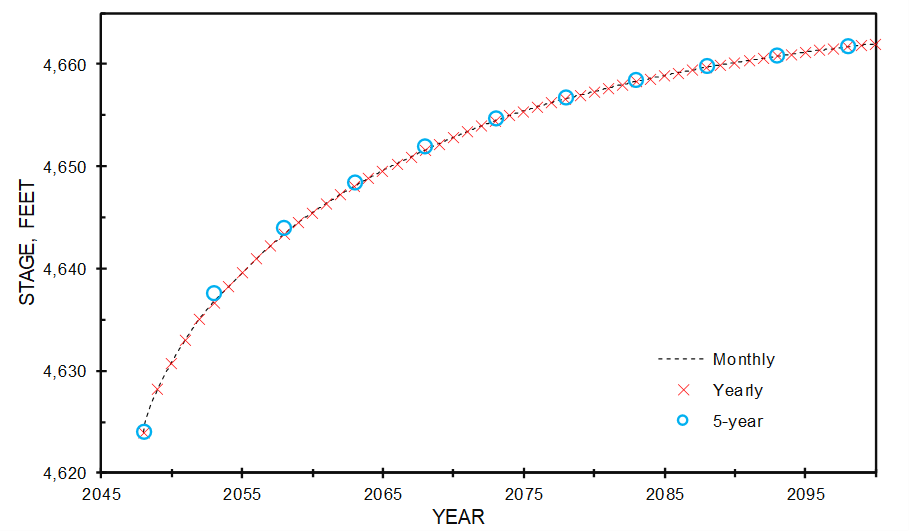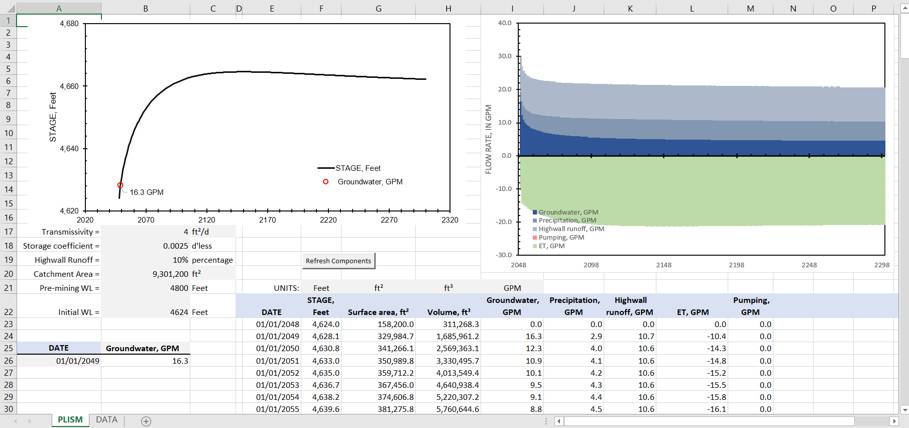Pit Lake Iterative Simulation Model or PLISM is an Excel workbook for simulating pit lake formation. Open-pit mines that extend below the water table create pit lakes. Assessing post-mining, pit-lake recovery and geochemistry requires a model that simulates time-dependent inflow and outflow components. The transient pit-lake model PLISM is a water-balance model that simulates groundwater exchange with the Jacob-Lohman equation (Lohman, 1972; Fontaine and others, 2003). Precipitation, highwall runoff, evaporation from the pit lake (ET), and external flows from pumping or injection also are flow components of the water budget in addition to groundwater exchange. Lake stage is related to surface area and volume of pit lake with lookup tables of pit geometry.
Lake stage is simulated with a water balance approach that iteratively solves for lake volume and stage. Lake volume at the end of a time step is estimated initially with the surface area at the beginning of the time step. Surface area of the pit lake affects estimated precipitation, highwall runoff, ET, and groundwater exchange volumes during a time step. Lake stage at the end of a time step is interpolated from the user-defined stage-area-volume relation. A revised lake volume at the end of the time step is estimated with a revised surface area from estimated lake stage at the middle of a time step. This process is repeated until estimated lake stages converge on a single value.
Lake stages estimated with PLISM are relatively insensitive to duration of time steps. Time steps for simulating lake stages are independent of times when precipitation and ET are tabulated. Precipitation and ET are specified as lengths (volume per unit area) during tabulated periods. These periods could be a month, a year, or 10 years, which would be lengths of 1, 12, and 120 inches, respectively, for rates of 12 in/yr. Monthly precipitation and ET are integrated if simulation periods are annual and interpolated if simulation periods are less than data tabulation periods. For example, lake stages were simulated for the pit lake characterized in the workbook Analytical_PLISM.v4.xlsm. Simulated lake stages differed little regardless of using monthly, yearly, and 5-year time steps (Figure 1). The maximum difference between solutions was less than 1 ft and errors did not propagate.

Data tabulation, pit-lake representation, and solution method in PLISM differs from traditional water balance models such as CRYPTIC (Fontaine and others, 2003). Data tabulation and lake-stage simulation times can differ in PLISM. Surface area and volume of pit lake are tabulated with lake stage. Stage-area-volume relation in PLISM is interpreted as a continuous function rather than as a limited series of discrete cylinders. Pit-lake stages and volumes are solved iteratively with PLISM rather than with forward differences. PLISM simulates highwall runoff as a function of pit-lake stage, which decreases potential runoff as lake stage increases.
The workbook consists of two pages, DATA and PLISM, and one hidden page, CONTROL. The hidden CONTROL page contains lookup tables, unit conversions, and charting utilities, which users should not need to edit. Pit-lake characteristics, simulated stage, and simulated flow components are reported on the PLISM page. Transmissivity, storage coefficient, percentage of highwall runoff, catchment area, pre-mining water level, and initial, pit-lake water level are specified on the PLISM page. Stage-area-volume relations, time series of precipitation and evaporation (ET) rates, and time series of volumetric pumping or injection rates are entered on the DATA page.

Analytical_PLISM.v4.xlsm and explanatory PDF can be downloaded with the following link.
Suggested Citation
Halford, Keith, 2023, PLISM – Pit Lake Iterative Simulation Model, version 4, Halford Hydrology LLC web page, accessed April 2023, at https://halfordhydrology.com/plism/
References
Fontaine, R.C., Andy Davis, and G.G. Fennemore, 2003, The Comprehensive Realistic Yearly Pit Transient Infilling Code (CRYPTIC): A Novel Pit Lake Analytical Solution, Mine Water and the Environment v.22 pgs. 187–193 https://doi.org/10.1007/s10230-003-0021-z
Jacob, C. E., and Lohman, S. W., 1952, Nonsteady flow to a well of constant drawdown in an extensive aquifer: Am. Geophys. Union Trans., v. 33, p. 559-569. https://agupubs.onlinelibrary.wiley.com/doi/abs/10.1029/TR033i004p00559
Lohman, S.W., 1972, Ground-Water Hydraulics:U.S. Geological Survey Professional Paper 708, 70 p. https://doi.org/10.3133/pp708
